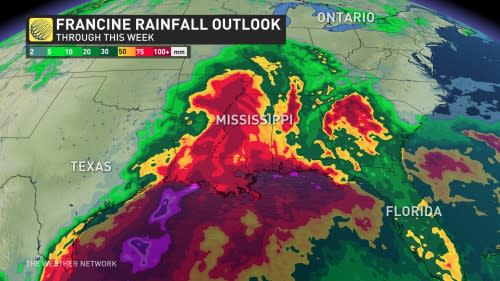


Francine is starting to show signs of intensification, with the expectation of it becoming a hurricane by or before Tuesday morning.
In fact, significant strengthening is forecast over the next couple of days, according to the latest update from the U.S. National Hurricane Center (NHC).
A hurricane warning has been issued for the Louisiana coast from Sabine Pass to Morgan City, while a hurricane watch continues from Morgan City eastward to Grand Isle, among other alerts including storm surge warnings and watches.
Visit The Weather Network’s hurricane hub to keep up with the latest on tropical developments in Canada and around the world

Francine strengthened to tropical storm status on Monday under the influence of very warm waters in the western Gulf, as well as low vertical wind shear.
SEE ALSO: ‘ACE’ is the best way to measure a hurricane season’s ferocity
According to the NHC, Francine is anticipated to be just offshore of the coasts of northeastern Mexico and southern Texas through Tuesday, and nearing the Louisiana and upper Texas coastline on Wednesday.


The NHC predicts Francine will likely be our fourth hurricane of the year and will become a Category 2 before landfall along the Louisiana border on Wednesday. Category 2 hurricane winds have a minimum threshold of 154 km/h. As of Tuesday evening, the landfall location is likely to be in southern Louisiana, south of Lafayette.
Anywhere from 100-200 mm of rain, with up to 250 mm locally possible, is likely from the coast of northeast Mexico northward along portions of the southern Texas coast, the far upper Texas coast, and across southern Louisiana and southern Mississippi into Thursday morning.
“This rainfall could lead to the risk of considerable flash and urban flooding,” the NHC warns.
The combination of a dangerous storm surge and the tide will also cause normally dry areas near the coast to be flooded by rising waters moving inland from the shoreline, the NHC adds. That water could reach as high as three metres in some of the hardest-hit areas of Louisiana.


Swells generated by Francine are affecting portions of the coast of northeastern Mexico and southern Texas. These swells are expected to spread across the northwestern and northern Gulf of Mexico coastline during the next day or so.
“These swells are likely to cause life-threatening surf and rip current conditions,” says the NHC.
Impacts to Canada are looking less likely, with a strong ridge of high pressure protecting Eastern Canada from the remnants.
There are currently two other areas in the Atlantic basin showing signs of probable development, as well, and will need to be monitored as the week wears on.